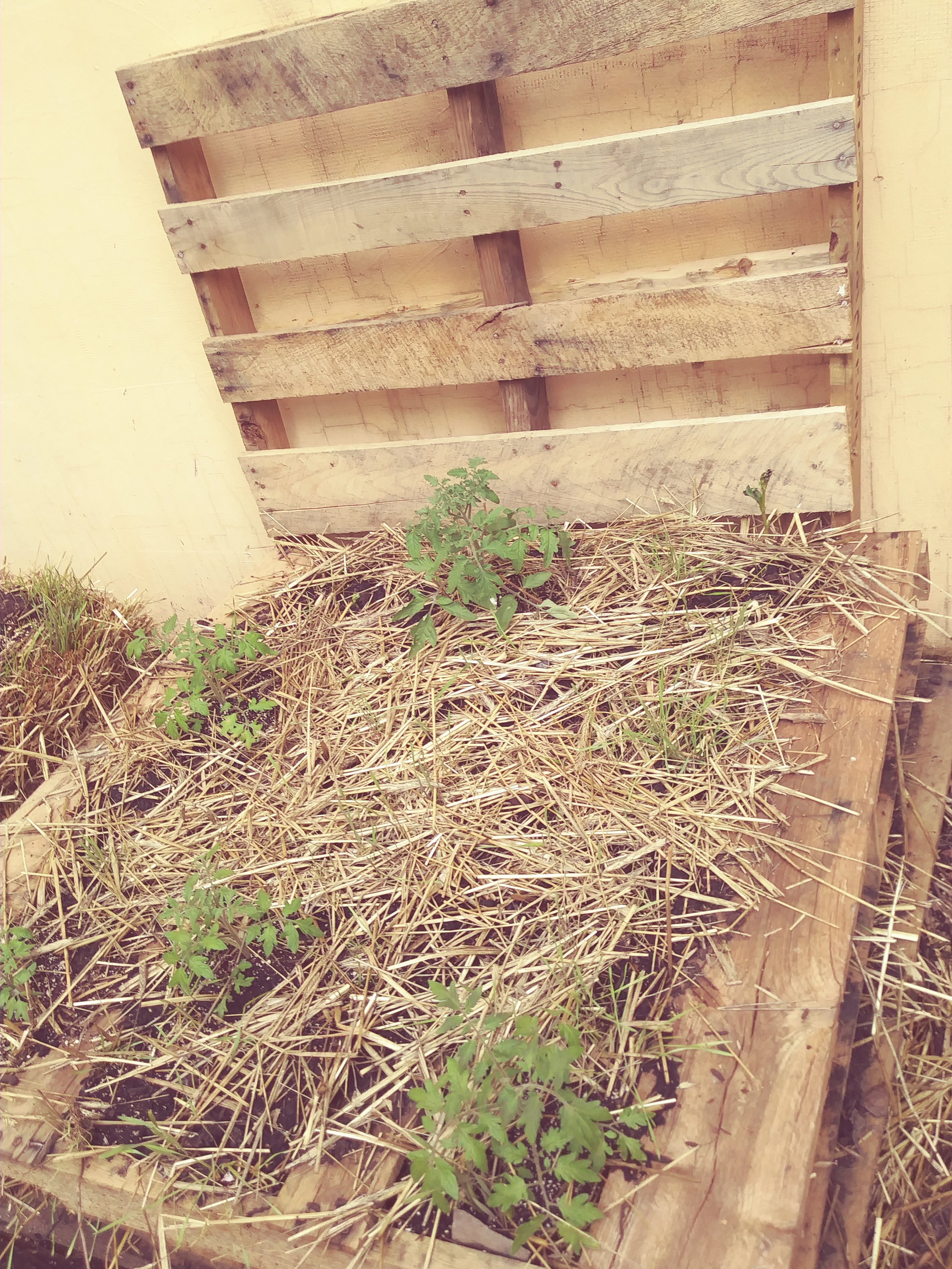Learn as You Grow: My Tomato Growing Operation’s First Two Years
By Bobi Wood
One thing about growing tomatoes is, everybody’s got an opinion. It’s a topic that people care deeply about, and gardeners are a generous folk, always ready to share what they’ve learned about horticulture. Talk to enough people about growing tomatoes, and you will find that the opinions of some gardeners will directly contradict those of other gardeners. Growing tomatoes is almost like being pregnant—every one is going to chime in with a piece of parenting advice!
In my first year of tomato growing, the spring and summer of 2018, I was told to put Christmas tree lights under the seedling tray, to plant directly in the ground when the weather’s warm enough, to plant indoors in April, to plant in pure compost, to not, to only make my own seed-starting mix, and many more well-intentioned, and contradictory, pieces of advice.
I think the best pieces of advice came from my neighbor, who said, “Gardening really is all about a process of trial and error,” and a lifelong gardener who shushed me when I told her I felt so guilty about my first batch of seedlings dying. She said, “I can’t count the things I’ve killed. That’s how I’ve learned.”
In the end, growing tomatoes is going to be a process of trial and error.
Last spring, I placed a tray of tomato seeds in seed starting mix on top of my refrigerator. This was a first for me. I had never attempted growing tomatoes before, and I was excited, because I love tomatoes and wanted to taste one that, well, tasted like I remember tomatoes as tasting: an explosive sweetness with a flavor bouquet of earthy spice, and a texture that is at once firm and yielding. And that smell! I stopped buying tomatoes years ago when the flavor made me feel sad and nostalgic.
I was armed with information generously provided by a class at the Brooklyn Botanic Garden. I knew, for example, to always water from the bottom, because water hitting the plants can cause fungus and death of the plants, particularly when they are small.
I checked my tomato seedlings every day. Then one day, I saw the first tiny green sprouts popping up from the top of the planter. I thought about all of the delicious recipes I was going to put them into. In just a few weeks, they were starting to look like real tomatoes in training.
Until they vanished into thin air overnight. One minute they were there, the next they weren’t.
It was strange.
This is called damping off disease. I might not have kept the seedlings dry enough. Or it might have been because I didn’t shut the window, and they caught cold and damped off. The plants actually seemed to have evaporated—there was no seedling lying over in the starting mix, or anything. It was as if they had never even existed.
I planted another set, put them on top of the fridge to germinate, and went through the cycle of excitement again. The second time around, the tomato seedlings didn’t TK dampen off, but they never fluffed out. I was only to experience severe disappointment as the seedlings grew taller and taller, but refused to put out new leaves. They never fluffed out to look like the heartier plants you buy in the nursery. This is because I skipped the step of setting them up with a dedicated overhead light, to simulate the sun.
And so I went to the nursery, and bought some tomato plants, some of which were the variety I had tried to grow in Round One. That very afternoon, I planted them in the garden. The soil was already above 65 degrees every day, and they took to their planting bed, which we constructed out of wooden pallets and filled with a combination of straw and compost—hardly any soil, as I worried that the soil in the backyard might be contaminated.
For some reason, I believed that in order to produce tomatoes, the plants had to have their flowers pinched off. This is incorrect. Where there is a flower, there will be a tomato. Therefore, you do not want to pinch off the flowers. It took me a while to figure this out.
They grew well, and yielded some very tasty tomatoes. The season ended, I said to my partner, “Next year I’m going to start planting the seeds earlier in the year, and do a better job with lighting so the tomatoes can be bigger before I put them outside.”
He was unconcerned. He enjoys a good tomato, but not as much as I do. “Why don’t you grow potatoes or onions?” he asked. ”Things I actually eat?”
Because tomato growing is a challenge, and I like a challenge.
This year, after watching a You Tube tutorial, I lined a plastic sweater box with aluminum foil, and set it up with studio lights over the top to provide the tomato seedlings with additional warmth until they got big enough to transplant outside. They grew well, much better than last year, and they fluffed out, growing leaves all over the place so that they looked more like bushy tomato plants than palm trees.
Unfortunately, I got over-enthusiastic about putting them in the ground, and after a week’s time of “hardening off”, I put them gently into their tomato growing bed.
That was right before the massive rains started. Three of the tomato seedlings survived. Out of a starting total of fifteen?
There were also cherry tomatoes seedlings around a month ago, which I started from fresh organic cherry tomatoes. They didn’t make it, either. I read directions for separating the tiny seeds from the pulp and carefully drying the seeds before planting them. Always one to go my own way, I simply pulled the tomato seeds out and stuck them in the dirt, which was no longer official seed mix but just regular dirt. I believe they needed the lights closer to them, or farther away. Or more lights, with greater distribution across the box.
One trick I learned is to grind up egg shells in a food processor to dish into the bottom of the hole in the ground before you put the tomato seedling in, to add calcium for healthier tomatoes. Another is to add an aspirin to some water and stir it until it dissolves. You then feed this aspirin water to your seedlings upon transplant in order to help prevent transplant shock and create greater resiliency to disease.
This years’ tomatoes are starting to flower now. This year I am trying a companion planting of marigolds, which are a plant “ally”, and emit a chemical to help protect the tomatoes from certain insects. I also am trying a homemade anti-insect repellant made from water, dish washing liquid, and neem oil. If you try this, use only a couple of tablespoons of neem oil to a gallon of water, or you will burn the leaves because neem oil apparently is very strong. I learned this the hard way on my beloved burdock plant.
Who am I to give advice about growing tomatoes? Everyone has to start somewhere, and truly, reader, if I can raise a summer crop of tomatoes, you can!
DO:
Start your seeds indoors around a month and a half before you want to put them in the ground.
DO use adequate light source over the seedlings, but don’t leave it on 24/7. The little tomato seedlings need to rest, just as they will when they’re outside.
Pick the sunniest location available when you plant them outside.
Use a lot of compost, but not 100% compost.
Water from the bottom by using a dish or tray underneath your tomato planter.
Talk to your tomato plants. They also seem to enjoy gentle petting.
DON’T:
Pinch off the flowers. That’s what turns into tomatoes!
Place the seed trays in a window that doesn’t get A LOT of sun.
Allow your tomato seedlings to get cold by catching a draft.
Be in a rush to put the tomato plants in the ground before the outdoors soil temperature is consistently warm.
Cry too long or too hard if your first efforts result in failure. Think of it like playing baseball: there’s always next year!




